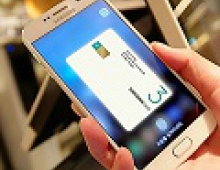
Samsung Pay Launches In The U.S.
Last month, Samsung made available the Samsung Pay in its home country and today the mobile payment service is available to owners of select Samsung phones in the US. Samsung's mobile payment system works in almost all stores and almost all point of sale systems: NFC, magnetic stripe and EMV (Europay, MasterCard and Visa) terminals for chip-based cards. However, it won't work with readers where you need to physically insert your card into a slot such as those found at gas stations and on an ATM.
However, thereare some restrictions. For now, Samsung Pay only works with four Samsung phones: the Galaxy S6 Edge+, Galaxy Note 5, Galaxy S6 and S6 Edge. It will also be available on the Gear S2 smartwatch when it is released, but only for transactions on NFC terminals.
The phone also needs to be on one of the following carriers in the United States: AT&T, Sprint, T-Mobile or US Cellular.
In addition, you will need a Visa or MasterCard issued by Bank of America, Citibank or US Bank. American Express is also supported.
As soon as you have iinstalled the Samsung Pay app to your phone, you should register your fingerprint on the device. The camera will launch so you can scan your credit or debit card. Check that the number, name and expiration date are all correct. Finally, the app will need to verify the card by sending you an SMS or email from your bank.
The system also works with almost all other magnetic stripe terminals as well. Samsung Pay uses Magnetic Secure Transmission (MST) when the phone is held against one of these registers. The phone emits a magnetic signal that simulates the magnetic strip found on the back of a credit or debit card.
Samsung Pay comes a year after Apple Pay launched, and without the broad reach of Android Pay. The main difference is that Samsung Pay works at almost all stores that accept credit or debit cards, not just those with tap-to-pay NFC terminals.
Samsung Pay does not store the account or credit card numbers of cards on the device, instead using tokenization for transactions. Each time a purchase is made, the Samsung Pay handset sends two pieces of data to the payment terminal. The first is a 16-digit token that represents the credit or debit card number, while the second piece is a one-time code or cryptogram that's generated by the phone's encryption key.
Payments can't be made from your phone without being authorized via fingerprint or the PIN chosen during the setup process. If you register with Samsung's Find My Mobile service you can remotely erase information on the phone, including any cards stored in Samsung Pay.
Future rollouts of Samsungs' payment system include the UK, Spain and China.





















